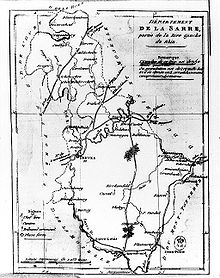Department de la Sarre
The Département de la Sarre ( German Saardepartement , also Saardépartement ) is a former department that was established after the conquest and annexation of the German territories on the left bank of the Rhine during the Revolutionary Wars by the French revolutionary armies (1794): It was established under international law through the Peace of Lunéville part of France on February 9, 1801. It stretched from the northern Eifel near Blankenheim to what is now Saarland . Most of the 4935 square kilometers area was previously part of the Electorate of Trier . The population was 273,569 inhabitants (1809).
Classification from 1798
The "General Government Commissioner of all conquered countries between the Meuse and Rhine and Rhine and Moselle", the Alsatian Franz-Josef (François Joseph) Rudler , initially ordered the division under the 4th Pluviôse an VI (= 23 January 1798) of the Saar department in 31 cantons, namely Trèves, Pfalzel, Dreis, Berncastel, Budelich, Grimbourg, Sarrebourg, Merzig, Lebach, Tholey, Birkenfeld, Baldenau, Wittlich, Schoeneck (en), Prum, Schoenberg, Stadtkyll, Gerolstein, Daun, Manderscheid, Herstein, Grumbach, Baumholder, St. Wendel, Kusel, Hochem, Ottweiler, Sarrebruck, Bliescastel, Reifferscheid and Blankenheim.
This division was changed under the 22nd Ventôse to VI (= March 12th 1798), especially since the canton Tholey, which belongs to the Moselle department, should not have been allocated otherwise by Rudler alone. The department has now been divided into 34 cantons; This division remained in effect until 1815, with the exception of the relocation of individual cantonal seats.
administration
The prefecture of the Département de la Sarre was located in Trier in the building of the Palais Walderdorff . With the ordinance of 24th Floréal on VIII (= 14th May 1800) it was decreed that the administrative structures were also set up in the four Rhenish departments, which were still under special administration due to the unclear state legal position, according to the law of 28th Pluviôse on VIII which had reorganized the administration of the French Republic. It was determined that the meeting places of the breeding police courts (tribunaux de police correctionnelle) that had already been introduced - in the Saardepartement Trier, Prüm, Saarbrücken and Birkenfeld - should be the main places of the Arrondissements communaux and thus the seat of the sub-prefectures. This resulted in the distribution of the cantons among the arrondissements:
-
Trier (Trèves) with the cantons :
Bernkastel , Büdlich , Konz , Pfalzel , Saarburg , Schweich , Trier and Wittlich ,
-
Birkenfeld with the cantons:
Baumholder , Birkenfeld , Grumbach , Hermeskeil , Herrstein , Kusel , Meisenheim , Rhaunen and Wadern ,
-
Prüm (Prum) with the cantons:
Blankenheim , Daun , Gerolstein , Kyllburg , Lissendorf , Manderscheid , Prüm , Reifferscheid and Schönberg ,
-
Saarbrücken (Sarrebruck) with the cantons:
Arnual , Blieskastel , Lebach , Merzig , Ottweiler , Saarbrücken , Sankt Wendel and Waldmohr .
List of prefects
- 1800–1803: Joseph Bexon d'Ormschwiller
- 1803–1810: Maximilien Xavier Képler (German alternative spelling: Keppler; since 1808 Chevalier Képler, since 1810 Baron Képler)
- 1810–1813: Alexandre François de Bruneteau de Sainte Suzanne (from 1812 de Bruneteau, Baron de Sainte Suzanne)
Dissolution of the department
After the expulsion of the French at the beginning of 1814 in the course of the wars of liberation and finally after the Congress of Vienna in 1815, the Saar Department came almost entirely to the Kingdom of Prussia on the basis of several treaties . Only the cantons of Kusel , Waldmohr and Blieskastel came to the Kingdom of Bavaria (May 1816). However, Prussia and Austria had agreed to fulfill the territorial claims from Article 49 of the Vienna Congress Act alone. As a result, large parts of the Birkenfeld arrondissement in particular came to three princes:
- The Duke of Saxe-Coburg-Saalfeld received the cantons of Grumbach (with the exception of 6 villages), Sankt Wendel (with the exception of 19 villages), Baumholder (with the exception of 4 villages) and 6 villages in the canton of Kusel, 12 villages in the canton of Tholey and 8 villages from Canton of Ottweiler. The Duke of Saxony-Coburg-Saalfeld initially referred to this area as "Herrschaft Baumholder", later the acquisition in the Principality of Lichtenberg was renamed after Lichtenberg Castle (September 1816).
- The Landgrave of Hessen-Homburg also received the canton of Meisenheim in September 1816, which he had administered as the Oberamt Meisenheim of his principality.
- The Grand Duke of Oldenburg finally received, partly in full, partly in part, the cantons of Herrstein, Birkenfeld, Hermeskeil, Wadern, St. Wendel, Baumholder and Rhaunen. Since the Grand Duke wanted to receive territorial compensation closer to his northern German home countries instead of this distant exclave, the transfer of this area, known as the Principality of Birkenfeld , dragged on until April 16, 1817.
literature
- Albrecht Friedrich Ludolph Lasius : The French Kayser State under the government of Kayser Napoleon the Great in 1812. A historical manual, First Department, Osnabrück bey Johann Gottfried Kißling, 1813, p. 447 ( Google Books )
Web links
- Imperial Austrian patent for assignment of various districts in the former Saardepartement to Prussia from July 1, 1816 ( Google Books )
- Royal Prussian patent for taking ownership of various districts in the former Saar department from July 1, 1816 ( Google Books )
Individual evidence
- ↑ Bulletin des lois de la République française No. 25 of the year VIII .
- ↑ Lancizolle, overview of the German imperial estate and territorial relationships ... , Berlin 1830 ( at Google Books, pp. 128 and 129 )

